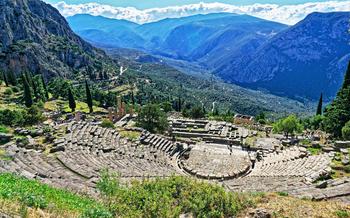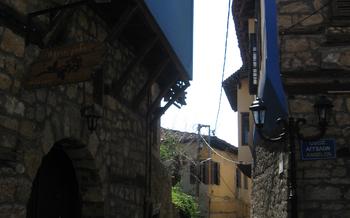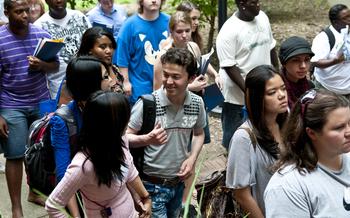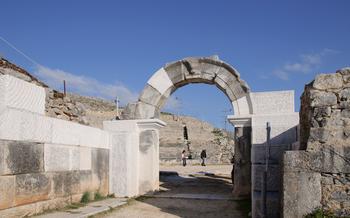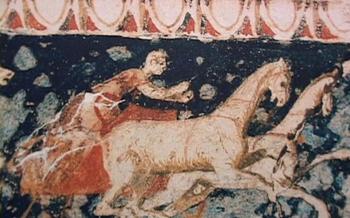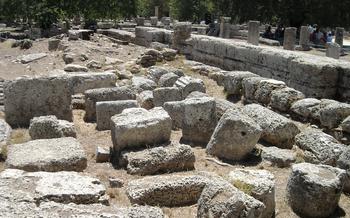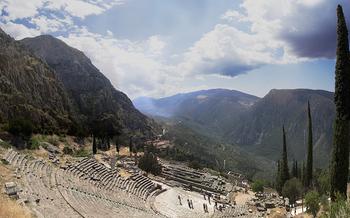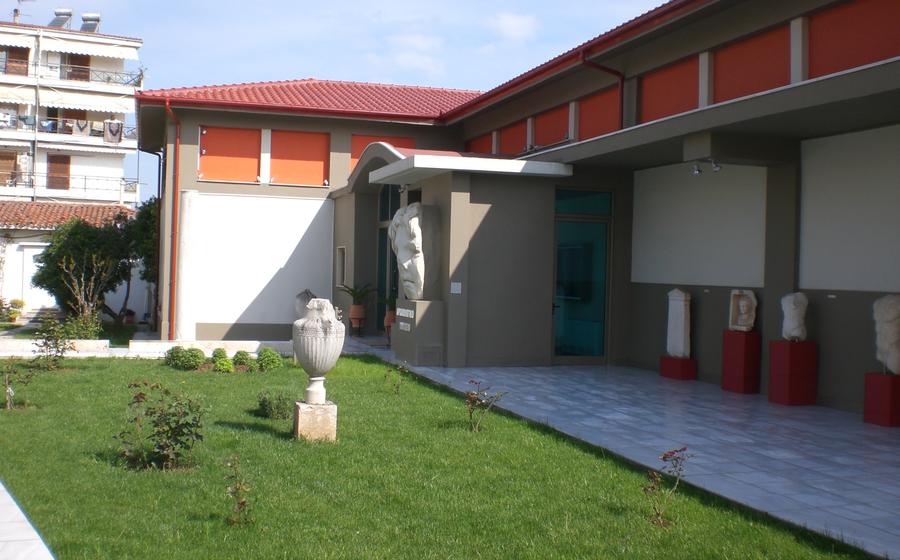
Archaeological Museum of Veroia
- Historical Overview
- Museum Highlights
- Thematic Galleries
- Ancient Artifacts
- Interactive Displays
- Temporary Exhibitions
- Educational Programs
- Accessibility and Facilities
- Insider Tip
- Admission and Hours
- Guided Tours
- Photography and Videography
- Souvenirs and Gifts
- Nearby Attractions
- Local Cuisine and Dining
- Insider Tip:
Historical Overview
Veria, an ancient city in northern Greece, boasts a rich history dating back to the Neolithic period. Once a prosperous Roman colony, Veria served as a significant trade and cultural center. The Archaeological Museum of Veroia, established in 1965, stands as a testament to the city's illustrious past. It houses an impressive collection of artifacts unearthed from archaeological excavations conducted in and around Veria. These artifacts, spanning various eras from prehistory to the Byzantine period, provide valuable insights into the city's evolution and the lives of its inhabitants. The museum's exhibits offer a glimpse into the region's artistry, craftsmanship, and cultural heritage, making it a must-visit destination for history enthusiasts and travelers seeking to delve deeper into Greece's past.
Museum Highlights
The Archaeological Museum of Veroia is home to a treasure-trove of artifacts that offer a glimpse into the rich history and culture of the city. Among the must-see exhibits are the exquisite gold jewelry, handcrafted by skilled artisans during the ancient era. The delicate necklaces, intricate earrings, and opulent rings showcase the exceptional craftsmanship and artistic prowess of the ancient Greeks.
Another highlight of the museum is its impressive collection of pottery, ranging from simple utilitarian vessels to elaborately decorated vases. These artifacts provide insights into the everyday lives of the ancient Verians, their customs, and their artistic sensibilities. The museum also boasts a remarkable collection of sculptures, including marble statues of gods, goddesses, and heroes, which offer a glimpse into the religious beliefs and mythology of the ancient Greeks.
What sets the Archaeological Museum of Veroia apart from others in Greece is its unique focus on the Hellenistic and Roman periods. The museum houses a wealth of artifacts from this era, including coins, inscriptions, and sculptures, which shed light on the city's transformation under Macedonian and Roman rule. These artifacts provide valuable insights into the cultural exchange and syncretism that occurred during this period of Greek history.
Thematic Galleries
The Archaeological Museum of Veroia is divided into several thematic galleries, each dedicated to a specific aspect of the city's rich history and culture. Here are some highlights of each gallery:
-
Prehistory Gallery: This gallery showcases artifacts from the Neolithic to the Bronze Age, providing a glimpse into the earliest settlements in the Veria region. Notable exhibits include pottery, tools, and figurines that shed light on the daily lives and beliefs of our ancient ancestors.
-
Classical Gallery: The Classical Gallery houses a collection of sculptures, pottery, and jewelry from the Classical period (5th to 4th centuries BC). Among the highlights are a life-size marble statue of Hermes, the messenger god, and a stunning collection of gold jewelry crafted with intricate detail.
-
Hellenistic Gallery: This gallery features artifacts from the Hellenistic period (3rd to 1st centuries BC), which witnessed the rise of Alexander the Great and the spread of Greek culture throughout the Mediterranean. Highlights include a bronze statue of a satyr, a mythological creature, and a collection of coins depicting Alexander's likeness.
-
Roman Gallery: The Roman Gallery showcases artifacts from the Roman period (1st century BC to 4th century AD), during which Veria flourished as a major city in the Roman province of Macedonia. Notable exhibits include a marble bust of the Roman emperor Trajan, as well as mosaics and pottery that provide insight into everyday life under Roman rule.
-
Early Christian Gallery: The Early Christian Gallery houses artifacts from the early Christian period (4th to 6th centuries AD), when Christianity was gaining prominence in the region. Highlights include a collection of Christian sarcophagi, decorated with biblical scenes and inscriptions, as well as a mosaic depicting the baptism of Christ.
Ancient Artifacts
The Archaeological Museum of Veroia houses an impressive collection of ancient artifacts that offer a glimpse into the rich history and culture of the region. Among the must-see exhibits are the exquisite gold jewelry, intricately decorated pottery, and lifelike sculptures that showcase the exceptional craftsmanship of ancient Greek artisans.
One of the highlights of the collection is a stunning gold necklace adorned with intricate filigree work and colorful gemstones. Believed to date back to the 4th century BC, the necklace is a testament to the opulence and artistry of ancient Greek jewelry makers.
Another remarkable artifact is a beautifully preserved red-figure vase depicting a scene from Greek mythology. The intricate details and vibrant colors of the vase bring the ancient story to life, offering visitors a glimpse into the rich artistic traditions of ancient Greece.
The museum also boasts an impressive collection of sculptures, including a majestic marble statue of a kouros, a young male figure, dating back to the 6th century BC. The statue's serene expression and elegant posture exemplify the classical ideals of beauty and harmony that characterized ancient Greek art.
Interactive Displays
The Archaeological Museum of Veroia features a range of interactive displays designed to enhance the visitor experience and make learning more engaging. These displays utilize modern technology to bring history to life and allow visitors to explore the museum's collection in a fun and interactive way.
One of the highlights of the interactive exhibits is a virtual reality experience that transports visitors back in time to ancient Veria. Using VR headsets, visitors can wander through the streets of the ancient city, visit important landmarks, and interact with virtual characters from the past. This immersive experience provides a unique and memorable way to learn about the history and culture of Veria.
Another popular interactive display is a 3D model of the ancient city that allows visitors to explore the layout of the city and its various buildings. Visitors can zoom in and out of the model, rotate it to view it from different angles, and learn about the history and significance of each structure.
The museum also offers interactive touchscreens that provide visitors with in-depth information about the artifacts on display. These touchscreens feature high-resolution images, videos, and interactive quizzes that allow visitors to test their knowledge and learn more about the museum's collection.
Temporary Exhibitions
The Archaeological Museum of Veroia frequently hosts temporary exhibitions alongside its permanent collection. These exhibitions showcase specific themes, spotlight lesser-known aspects of ancient Greek culture, or present new discoveries from ongoing archaeological excavations. Temporary exhibitions add variety and freshness to the museum's offerings, ensuring that there is always something new to explore for returning visitors.
Recent temporary exhibitions have delved into topics such as ancient Greek athletics, the history of winemaking in Macedonia, and the role of women in ancient society. These exhibitions often feature unique artifacts, interactive displays, and educational panels that enhance the visitor experience. By incorporating temporary exhibitions into its programming, the Archaeological Museum of Veroia demonstrates its commitment to promoting ongoing research and shedding light on different facets of ancient Greek history and culture.
For visitors planning a trip to the museum, it is advisable to check the museum's website or social media pages for information on current and upcoming temporary exhibitions. These exhibitions offer an opportunity to delve deeper into specific areas of interest and gain a more comprehensive understanding of ancient Greek civilization.
Educational Programs
The Archaeological Museum of Veroia offers a range of educational programs designed to enhance the visitor experience and provide a deeper understanding of the exhibits. These programs are suitable for visitors of all ages and backgrounds, including families, students, and history enthusiasts.
One of the most popular programs is the guided tour. Led by knowledgeable museum guides, these tours provide insights into the history of Veria, the significance of the artifacts, and the stories behind the exhibits. Visitors can choose from a variety of tours tailored to their interests and time constraints.
The museum also offers educational workshops and lectures throughout the year. These programs focus on specific aspects of Greek history, archaeology, and art. Participants can learn about ancient pottery techniques, explore the mythology surrounding the gods and goddesses, or delve into the history of the Macedonian kingdom.
For families with children, the museum has developed interactive activities and educational games that make learning about history fun and engaging. These activities encourage children to explore the exhibits, ask questions, and develop their critical thinking skills.
By participating in the educational programs offered by the Archaeological Museum of Veroia, visitors can gain a deeper appreciation for the rich history and culture of Greece. These programs provide an opportunity to learn from experts, engage with the exhibits, and create lasting memories.
Accessibility and Facilities
The Archaeological Museum of Veroia is committed to providing an accessible and welcoming environment for all visitors. The museum is wheelchair accessible, with ramps and elevators throughout the building. Visitors with disabilities can also request assistance from the museum staff, who are happy to help.
In addition, the museum offers a variety of amenities to make your visit more enjoyable. There is a gift shop where you can purchase souvenirs and books about the museum and its collection. There is also a cafe where you can relax and have a snack or a drink. And if you need to store your luggage or belongings, there is a cloakroom available.
Insider Tip
If you are visiting the Archaeological Museum of Veroia during the summer months, be sure to take advantage of the museum's evening hours. The museum is open until 8 pm on Tuesdays and Thursdays, giving you plenty of time to explore the exhibits without the crowds.
Admission and Hours
Admission to the Archaeological Museum of Veria is quite affordable, making it accessible to visitors of all budgets. The museum's hours of operation are convenient for both morning and afternoon visits, allowing travelers to easily fit it into their itinerary. To avoid crowds and enjoy a more personalized experience, it's advisable to visit during the early morning hours or on weekdays outside of the peak tourist season.
For those planning an extensive visit or seeking a deeper understanding of the exhibits, guided tours are available at an additional cost. These tours provide valuable insights and historical context, enhancing the overall museum experience.
Guided Tours
Enhance your visit to the Archaeological Museum of Veroia by opting for a guided tour. Professional guides, fluent in various languages, are available to provide insightful commentary and historical context that bring the exhibits to life. These tours offer a deeper understanding of the artifacts and their significance within the broader context of Greek history and culture. With a guided tour, you'll gain a richer appreciation for the museum's collection and leave with a lasting impression of Veria's rich heritage.
Photography and Videography
The Archaeological Museum of Veroia welcomes photography and videography enthusiasts to capture the beauty and historical significance of its exhibits. Visitors are free to take photographs and videos for personal use, allowing them to document their visit and share their experiences with others. However, the museum kindly requests that visitors respect the following guidelines:
-
Flash Photography: The use of flash photography is prohibited within the museum to protect the delicate artifacts from damage. The museum's lighting is designed to provide optimal viewing conditions without the need for additional lighting.
-
Tripods and Selfie Sticks: The use of tripods and selfie sticks is generally not allowed in the museum. These items can obstruct the flow of visitors and may pose a safety risk in confined spaces. Visitors are encouraged to use handheld photography or request assistance from the museum staff if needed.
-
Respect for Others: Visitors are reminded to be mindful of other visitors while taking photographs or videos. Please avoid blocking others' views or disrupting their enjoyment of the exhibits.
-
Commercial Use: Any commercial use of photographs or videos taken in the museum requires prior permission from the museum authorities. Please contact the museum's administration for further information and to obtain the necessary authorization.
By adhering to these guidelines, visitors can help preserve the museum's collection and ensure a pleasant and enjoyable experience for all.
Souvenirs and Gifts
At the Archaeological Museum of Veroia, visitors can find a well-stocked gift shop that offers a variety of souvenirs and gifts inspired by the museum's collection. From replicas of ancient artifacts to books on Greek history and mythology, there's something for everyone.
For those looking for a unique and meaningful gift, the museum shop offers a selection of handmade items crafted by local artisans. These one-of-a-kind pieces, such as jewelry, pottery, and textiles, are a great way to remember your visit to Veria.
The museum also offers a range of educational materials, including children's books, activity sheets, and puzzles. These resources are a great way to share the wonders of ancient Greece with young learners.
Whether you're looking for a souvenir to remind you of your trip or a gift for a loved one, the Archaeological Museum of Veroia's gift shop has something for everyone.
Nearby Attractions
After immersing yourself in the treasures of the Archaeological Museum of Veroia, take some time to explore the city's other cultural and historical landmarks. Just a short walk from the museum, you'll find the historic Veria Town Hall, an architectural masterpiece dating back to the 19th century. With its intricate carvings and elegant facade, it's a testament to the city's rich heritage.
Another must-see attraction is the Byzantine Museum of Veria, which houses a collection of stunning religious artifacts, including icons, frescoes, and manuscripts. The museum offers a glimpse into the city's rich Byzantine past and its enduring legacy.
For a taste of modern culture, head to the Veria Art Gallery, which showcases the works of local and international artists. Its rotating exhibitions provide a platform for contemporary artistic expression and offer a fresh perspective on the city's cultural scene.
To experience the natural beauty of the region, take a leisurely stroll along the Veria River, which meanders through the city, offering picturesque views and a tranquil escape from the hustle and bustle of urban life.
Combine history and culture with outdoor recreation by visiting the Veria Municipal Park, located on the outskirts of the city. With its lush greenery, walking trails, and playgrounds, it's the perfect place to relax, recharge, and soak up the serene atmosphere.
Local Cuisine and Dining
A visit to Veria is not complete without indulging in the city's culinary delights. After exploring the ancient artifacts at the Archaeological Museum, take a break to savor the flavors of traditional Greek cuisine. Veria boasts a range of restaurants and cafes that offer authentic and affordable dining options.
For a taste of local specialties, head to one of the tavernas in the old town. Sample dishes like "giatni," a slow-cooked lamb stew, or "tourlou," a vegetable casserole. Pair your meal with a glass of local wine from the nearby Naoussa region.
If you're looking for a quick and casual bite, try one of the many souvlaki stands or bakeries. Souvlaki, grilled meat skewers, is a popular street food in Greece and can be found almost everywhere. Don't miss out on the chance to try the delicious pastries and sweets, such as baklava and loukoumades, which are a staple of Greek cuisine.
For a memorable dining experience, reserve a table at one of the rooftop restaurants overlooking the city. As you savor your meal, enjoy panoramic views of Veria and the surrounding mountains.
Insider Tip:
For an unforgettable experience, time your visit to the Archaeological Museum of Veroia to coincide with one of the museum's special events or workshops. These events often feature guest speakers, hands-on activities, and unique insights into the ancient artifacts and history of Veria. Check the museum's website or social media pages for upcoming events and plan your visit accordingly.
